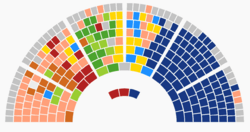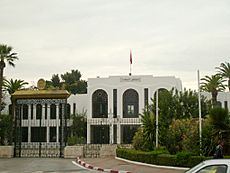Constituent Assembly of Tunisia facts for kids
Quick facts for kids National Constituent Assemblyالمجلس الوطني التأسيسي al-Majlis al-Waṭanī at-Ta'sīsī |
|
|---|---|
| Type | |
| Type | |
| History | |
| Founded | 22 November 2011 |
| Disbanded | 26 October 2014 |
| Preceded by | Chamber of Deputies |
| Succeeded by | Assembly of the Representatives of the People |
| Leadership | |
|
Speaker
|
Mustapha Ben Jafar, Ettakatol
Since 22 November 2011 |
|
First Deputy Speaker
|
Meherzia Labidi Maïza, Ennahda
Since 22 November 2011 |
|
Second Deputy Speaker
|
Larbi Ben Salah Abid, CPR
Since 22 November 2011 |
| Structure | |
| Seats | 217 |
 |
|
|
Political groups
|
Ennahda (89)
non-inscrit (53) Democratic Bloc (18) Congress for the Republic (16) Democratic Transition (13) Ettakatol (13) Democratic Alliance (12) Wafa Movement (10) |
| Elections | |
| Proportional representation in multi-member constituency party-lists | |
|
Last election
|
23 October 2011 |
| Meeting place | |
 |
|
| Bardo Palace | |
The National Constituent Assembly (NCA) was a special group of lawmakers in Tunisia. Their main job was to create a brand new constitution for the country. This happened after the old president, Zine El Abidine Ben Ali, left power.
The NCA was formed after an election on October 23, 2011. It had 217 members who represented Tunisians living both in Tunisia and abroad. The largest group in the Assembly was the Ennahda Movement, which is a moderate Islamist party. The Assembly first met on November 22, 2011. It finished its work and was replaced by the Assembly of the Representatives of the People on October 26, 2014.
Contents
Forming the Assembly: How it Started
When the NCA was first planned, people thought it would take about one year to write the new constitution. However, the Assembly itself got to decide its own timeline.
Before the first meeting, three main political parties — Ennahda, Congress for the Republic (CPR), and Ettakatol — made an agreement. They decided to share the top leadership roles in the new government.
Because of this agreement, Mustapha Ben Jafar from the Ettakatol party was chosen as the Speaker of the NCA. This happened when the Assembly first met on November 22, 2011. Two other members, Meherzia Labidi from Ennahda and Larbi Abid from CPR, were elected as Deputy Speakers.
Setting Up the New Government
A Temporary Constitution
On December 10, 2011, the Assembly approved a temporary constitution. This document was called the Law on the provisional organisation of public powers. It set out some important rules for how the government would work for a short time.
For example, it listed the requirements for becoming the president. To be president, a person had to be a Tunisian citizen (not also a citizen of another country). They also needed to have Tunisian parents, be a Muslim, and be at least 35 years old. Most of the delegates, 141 of them, voted to approve this temporary law.
Choosing an Interim President
Just two days later, on December 12, 2011, the NCA elected Moncef Marzouki as the temporary President of Tunisia. He was a human rights activist and a leader of the CPR party. A large number of delegates, 153, voted for him. Some opposition parties did not agree with the new temporary constitution, so they chose not to vote.
On December 14, President Marzouki chose Hamadi Jebali to be the Prime Minister. Jebali was the secretary-general of the Ennahda Movement. He then formed his government, which officially started work on December 24.
| Candidacy of Moncef Marzouki of the Congress for the Republic | ||
|---|---|---|
| Choice | Votes | % |
| 153 | 75.7 | |
| Against | 3 | 1.5 |
| Blank | 44 | 20.3 |
| Abstentions | 2 | 1.0 |
| Total | 202 | 100.0 |
| Voter turnout | 93.1 | |
| Electorate | 217 | |
| Source: AFP | ||
Writing the New Constitution
The actual work of writing the new constitution began on February 13, 2012. The Assembly created six different committees. Each committee was in charge of a specific part or theme of the constitution. For example, one committee worked on the introduction and the main rules.
Each committee had 22 lawmakers. The number of members from each political group in these committees matched their strength in the overall Assembly. One of the most important decisions was about the form of government. This means how the country's government would be structured.
The Ennahda movement wanted a parliamentary system. In this system, the parliament has a lot of power. However, other parties, like CPR and Ettakatol, preferred a semi-presidential republic. This system shares power between a president and a prime minister. After much discussion, the new Tunisian constitution was finally approved on January 26, 2014.
Political Parties in the Assembly
The table below shows how many members each political party had in the National Constituent Assembly. It shows the numbers right after the 2011 election and then again closer to when the Assembly finished its work in October 2014.
| Affiliation | Members | |||
|---|---|---|---|---|
| 2011 Election Results |
As of 5 October 2014 |
|||
| Ennahda Movement | 89 | 85 | ||
| Congress for the Republic (CPR) | 29 | 12 | ||
| Democratic Forum for Labour and Liberties (FDTL) | 20 | 12 | ||
| Democratic Alliance Party | - | 10 | ||
| Social Democratic Path (VDS) | - | 10 | ||
| Republican Party (PR) | - | 8 | ||
| Popular Petition/Current of Love | 26 | 7 | ||
| Wafa Movement | - | 6 | ||
| Voice of the Tunisian People | - | 6 | ||
| Nidaa Tounes | - | 6 | ||
| El Amen Party | - | 5 | ||
| The Initiative (Almoubadara) | 4 | |||
| Democratic Current | - | 4 | ||
| Movement of the Republic | - | 4 | ||
| Afek Tounes | 4 | 3 | ||
| Tunisian Workers' Communist Party (PTOL)/Workers' Party (PT) | 3 | |||
| Patriotic Construction Party | - | 3 | ||
| People's Movement/Popular Current | 2 | |||
| Free Patriotic Union (UPL) | 1 | 2 | ||
| Democratic Patriots' Movement (MOPAD) | 1 | |||
| Maghrebin Liberal Party/Maghrebi Republican Party | 1 | |||
| Progressive Struggle Party/Progressive People's Party | 1 | |||
| Tunisian Movement for Freedom and Dignity | - | 1 | ||
| Tunisian National Front | - | 1 | ||
| Al Iklaa Party | - | 1 | ||
| Third Alternative | - | 1 | ||
| Reform and Development Party | - | 1 | ||
| Progressive Democratic Party (PDP) | 16 | – | ||
| Democratic Modernist Pole (PDM) | 5 | — | ||
| Movement of Socialist Democrats (MDS) | 2 | — | ||
| Democratic Social Nation Party | 1 | — | ||
| New Destour Party | 1 | — | ||
| Equity and Equality Party | 1 | — | ||
| Cultural Unionist Nation Party | 1 | — | ||
| Independent lists | 8 | 17 | ||
| Total members | 217 | |||

